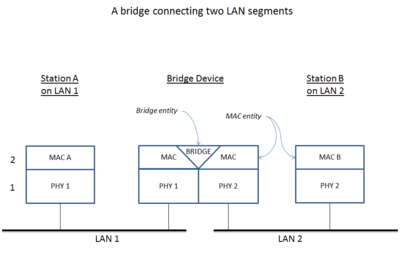
Back تجسير (نظم) Arabic Ponte de rede AST Мост (компютърни мрежи) Bulgarian Mrežni premosnik BS Pont de xarxa Catalan Bridge Czech Netværk bridge Danish Bridge (Netzwerk) German Γέφυρα δικτύου Greek Puente de red Spanish

A network bridge is a computer networking device that creates a single, aggregate network from multiple communication networks or network segments. This function is called network bridging.[1] Bridging is distinct from routing. Routing allows multiple networks to communicate independently and yet remain separate, whereas bridging connects two separate networks as if they were a single network.[2] In the OSI model, bridging is performed in the data link layer (layer 2).[3] If one or more segments of the bridged network are wireless, the device is known as a wireless bridge.
The main types of network bridging technologies are simple bridging, multiport bridging, and learning or transparent bridging.[4][5]
- ^ "Traffic regulators: Network interfaces, hubs, switches, bridges, routers, and firewalls" (PDF). Cisco Systems. September 14, 1999. Archived from the original (PDF) on May 31, 2013. Retrieved July 27, 2012.
- ^ "What is a Network Switch vs. a Router?". Cisco Systems. Retrieved July 27, 2012.
- ^ Decker, Eric B.; Langille, Paul; McCloghrie, Keith; Rijsinghani, Anil (July 14, 1989). "RFC 1286 - Definitions of Managed Objects for Bridges". Tools.ietf.org. Retrieved October 19, 2013.
- ^ "Local Area Networks: Internetworking". manipalitdubai.com. Archived from the original (PowerPoint) on May 13, 2014. Retrieved December 2, 2012.
- ^ "Bridging Protocols Overview" (PowerPoint). iol.unh.edu. Retrieved December 2, 2012.